SEO is vital for websites, but optimizing only for search engines is not enough. SEO evolves constantly due to changes in search engine algorithms and technological advancements. As SEO changes, your website must keep pace. This is where content audits become essential. A content audit is a critical part of an SEO audit, helping websites stay aligned with the latest updates in search algorithms and user expectations.
Regular content audits allow you to optimize your site for search engines and user experience, ensuring that your efforts yield the best possible results. Keep reading to learn how to conduct a periodic content audit and get the most out of your SEO efforts with our comprehensive web content audit guide.
What Is Content Audit?
Content audits assess the performance and quality of content on your website. As Bill Gates famously said, “Content is king.” High-quality content is crucial for success in the digital age, where users expect valuable and informative material. However, not all content meets this standard—there’s a lot of weak content online, which can harm your site’s SEO.
A content audit helps identify and improve weak content. This process involves evaluating the metrics of individual pieces of content and determining what’s working and what’s not. The ultimate goal is to improve the quality of your content, enhancing user engagement and boosting your site’s performance in search rankings. Best of all, a content audit is free if you know how to conduct one, and we’re here to guide you through the process.
What Is Weak Content?
Before diving into the audit process, it’s important to define weak content. Weak content fails to provide value to readers. It may be poorly written, overstuffed with keywords, copied from other sources, or too short to convey meaningful information.
Common types of weak content include:
- Classic weak content: Contains very little useful information.
- Superficial content: Provides little depth or value on the topic.
- Duplicate content: Copied from other sources with minimal changes.
- Keyword-stuffed content: Overloaded with keywords to manipulate rankings.
- Content with excessive errors: Contains multiple spelling and grammatical errors.
Weak content can damage your website’s performance in several ways. For example, it can lead to penalties from Google’s Panda and Hummingbird algorithms, which focus on identifying low-quality content. These penalties can result in de-indexing or a significant drop in traffic. To avoid these issues, it’s important to remove or optimize weak content before it harms your site.
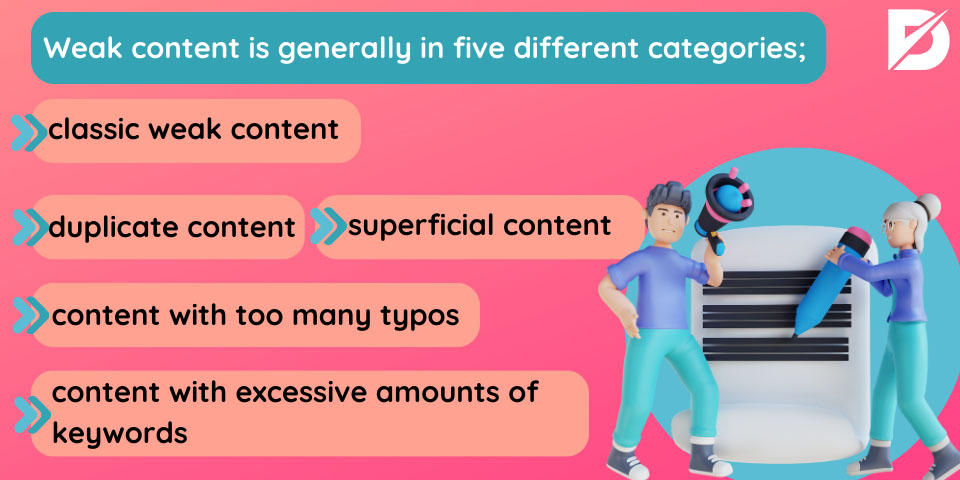
- The first of these categories is classic weak content. There is a trace amount of content in the article in these contents.
- Another category is called superficial content.
- Another weak content category is duplicate content, that is, stolen content. Content written by changing only the titles or some of them is also within this scope.
- Content with excessive amounts of keywords, written in a method known as keyword stuffing, is another category.
- Finally, content with too many typos is considered weak content.
Weak content does a lot of damage to the web pages and websites they are on in various respects. So, what are these damages? Let’s take a closer look at how weak content can harm websites.
What Damage Can Weak Content Do to the Website?
Google attaches great importance to content quality. For this, it has developed many algorithms to measure content quality. The most important of these algorithms are known as Hummingbird and Panda updates. Thus, Google may detect poor quality and weak content much more easily. As a result, weak or spammy content cannot escape punishment. Google commonly imposes de-index penalties on web pages with such content. Google sends a notification through Google Search Console to websites that face such a penalty. After this notification, the website in question will face significant problems, such as indexing and traffic. Website owners should strictly avoid using weak content to avoid such penalties. If your website contains web pages containing such content, remove this web page from the index yourself.
We guarantee that you will not benefit from such content anyway. For this reason, remove pages with content that does not benefit you or your visitors before they harm your website. Because such weak content is, first of all, extremely boring. In addition, because they are useless, they hardly attract the attention of users. For this reason, they rarely get clicks. Why would you have such content on your website? So, either optimize your content or remove it completely from your website before Google penalizes you. Because Google’s Panda and Hummingbird algorithms will eventually reduce the traffic of websites with such content.
The contents on the web pages are the main veins that feed your website. For this reason, content that has no value will fail to feed your website in terms of traffic. On the other hand, if your content is valuable, it will cause Google to value your website. As a result, your website will be fed and revitalized with even more traffic thanks to these contents.
Step-by-Step Content Audit
Step 1: Detect Weak Content
Start by identifying weak content on your website. Tools like Screaming Frog, Google Analytics, and CopyScape can help you spot low-performing or duplicate content. Ask yourself:
- Is the content informative?
- Is it engaging, or is it boring?
- Is the content up-to-date?
- Are the sources accurate?
Answering these questions will help you decide which content to improve or remove.
Step 2: Check Content Details
Analyze each piece of content by breaking it into components. Create a content audit chart that includes details like:
- Author and date of publication
- Content type and target
- Word count
- URL and engagement metrics (shares, comments, etc.)
Step 3: Evaluate Your Content
Now that you have the data, evaluate your content based on performance metrics like traffic, backlinks, and engagement. Divide your analysis into retrospective (past content) and ongoing audits (new content). Use tools like Semrush and Google Analytics to collect and analyze URLs and key data.
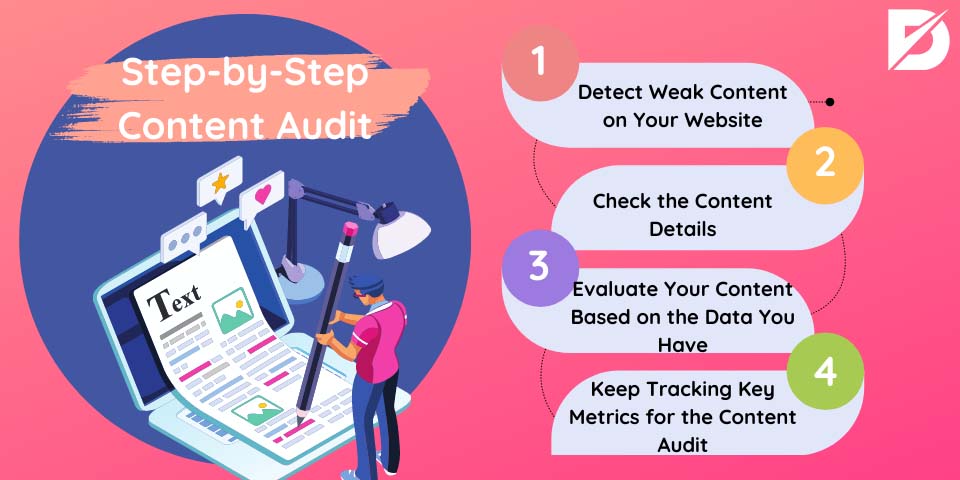
Detect Weak Content on Your Website
Detecting weak content is not always an easy task. More difficult than that is deciding whether you can optimize them or not. However, you don’t have to worry. There are many methods that you can apply for this, that is, that may help you in this process. First of all, there are many paid and free software that you can use for this. On the other hand, you can successfully detect the content on your website with manual methods. For this, you will have to look for answers to a few questions.
First of all, make sure that the content in question is informative enough. On the other hand, try to understand whether they are boring by examining these contents from the eyes of the readers. One of the most important issues that affect the quality of content is timeliness. Google places a lot of emphasis on up-to-dateness, especially for certain topics. You should also make sure that the topics of the content are of a type that may attract the attention of users. Finally, it is also important which resources you used while creating the content in question. Because this issue directly concerns the accuracy of the information contained in the content. That is one of the issues that Google attaches great importance to always. So, what are the tools that may help you to examine the contents in these respects that we have mentioned?
You can use Microsoft Word’s Spelling & Grammer Checking feature to check your content for these issues. Another tool you can use for this is Screaming Frog. This tool allows you to scan the weaknesses of the content on your website in detail. You may also use the CopyScape tool to detect whether the content on websites is duplicated.
Check the Content Details
You need to separate the contents into their smallest components at this stage. Here, start with the creation phase of the content. Also, pay attention to details such as basic broadcast information. For example, prepare a content audit chart on this subject. In this chart, give priority issues related to the creation process. Include the author of the content, the team that created it, and the date of the content.
Include the content type, content target, title, and word count related to the content issues. You may also evaluate how long the readers will need to consume the content under this category. It would be appropriate to add the URL of the content related to the technical structure of the content. You may also add the total amount of shares and comments about the engagement data of the content to this chart. You will need to evaluate your content if you have completed your chart.
Evaluate Your Content Based on the Data You Have
This process is the most important part of content auditing. For this reason, you may contribute to the process by creating new charts at this step. In this step, you should divide the process of evaluating your content according to the data into two. In other words, you should review your content retrospectively and on-going. Start by first evaluating your content retrospectively data. The retrospective audit will make a great contribution to both editing and preparing future content. Make sure you devote enough time to this process. Because this is the most time-consuming process of content auditing. Now let’s share how to perform this process step by step.
- First, decide how far in the past you will examine your data. In this regard, many SEO experts recommend that you go back for about one year on average.
- In the second step, collect the URLs of all the content you have published up to the point you set.
- You may get help from some tools while collecting these URLs. For example, Semrush and Google Analytics are the best SEO tools you can use in this regard.
- If you’ve collected the URLs of past content by following the steps above, now is the time to review important data.
If you were able to finish the retrospective content audit, now there is the ongoing audit. You must have added historical data to a chart. You should do the same for the content that you will publish periodically. Now continue to chart key data about your new content on a weekly basis. This way, you won’t have to go through the hassle of doing a retrospective audit again. Continue to add data about your content to the chart periodically throughout this process patiently.
Keep Tracking Key Metrics for the Content Audit
Key Metrics to Track in a Content Audit
When conducting a content audit, focus on the following metrics:
- Conversions: Regularly track content that drives conversions and tweak underperforming pieces.
- Organic Traffic: Exclude traffic from paid ads to focus on SEO-driven performance.
- Bounce Rate: A high bounce rate suggests that visitors leave quickly, indicating poor content quality.
- Backlinks: Separate high-quality from low-quality backlinks to enhance your SEO.
- Time on Page: Short time spent on a page with long content indicates potential engagement issues.
- Unique Visitors: More unique visitors suggest that your content attracts diverse audiences.
- Pages Per Session: High pages per session mean that visitors are exploring more content on your site.
- New and Returning Users: Track these metrics to understand how well your content retains and attracts users.
- Traffic Sources: Knowing where your visitors come from helps you optimize content for those platforms.
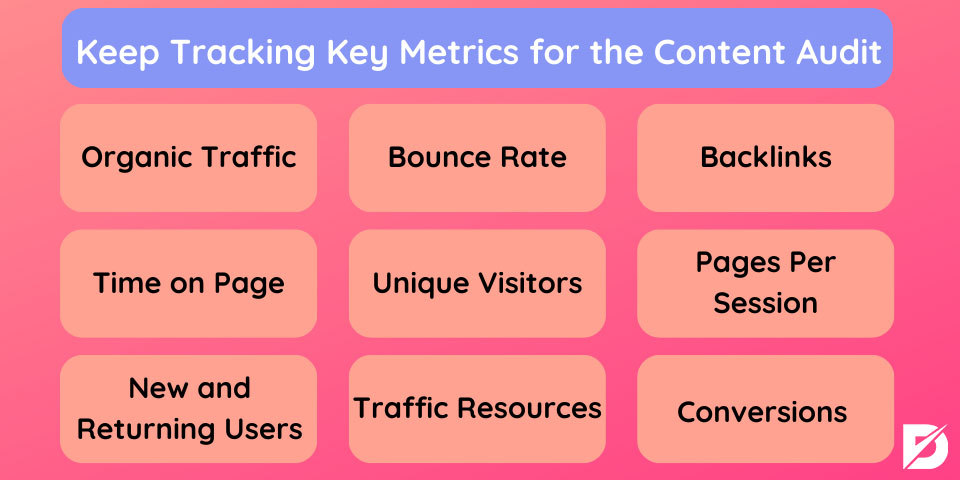
Organic Traffic
Organic traffic data ranks first among these important metrics. Whether your content is high quality or poor quality, it will definitely attract some organic traffic over time. There is something you should pay attention to at this point. You should not include traffic you get using paid advertisements in this data. At this point, you can clearly see that your content is not attracting satisfactory levels of traffic. Take this as a warning. And try to spot problems in your content. For example, the content strategy you are following may be wrong. On the other hand, a wrong content distribution strategy may also result in low organic traffic. You should consider that there may also be a problem with the type of content. If you haven’t encountered a significant problem with any of these, the content itself may be the source of the problem.
Bounce Rate
One of the most important signals that the content is bad is bounce rates. Bounce rate means that users who click on a web page leave the page in a short time. So, visitors probably didn’t like what they saw when they came to your web page. So, how do you fix this problem? While preparing your content, you should ensure that they move forward in a way that persuades users to stay on your website. For this, you should prepare the introduction and development parts of your content carefully. You should also make sure that your content encourages readers to do research on your website. In this way, users will continue to stay on your website after consuming the content on your website. So, what should bounce rates ideally be?
You should not think that there is a clear ideal figure for this. But, a bounce rate of at least 30% is normal for almost any website. In some cases, this figure can go up to 50%.
Backlinks
Another factor that may make the quality of content on websites better or worse is backlinks. For this reason, you should carefully examine the backlinks when doing the content audit. In such cases, you should be aware that only quality backlinks can increase the quality of your content. On the other hand, bad-quality backlinks will worsen the quality of your content. For this reason, you should definitely separate bad backlinks in the content audit. Thus, only quality backlinks that can increase the quality of your content will remain.
There is something you need to be careful about backlinks in the content audit that you’ll carry out on a regular basis. It will not be enough to examine one content once in terms of backlinks in the content audit. Because the backlinks of that one content will increase with time. For example, the backlinks of one content may be more than a dozen in a week. However, this number will be in the hundreds in a few months. That is exactly why you should check backlinks for each content regularly during every content audit process. In this way, you can always weed out the poor-quality links that your content will earn. Removing bad-quality backlinks earned by content will increase both content quality and ranking.
Time on Page
The time visitors spend on your web pages may also provide important clues about the quality of your content. For this reason, you should definitely take a look at this metric in the content auditing process. So, how can you tell whether your content is of good quality by looking at the time visitors spend on your web page? First of all, let’s say something else important. The short time visitors spend on your web page doesn’t always mean that the content on that page is of poor quality. Maybe these contents just don’t appeal to them. These contents may not be in their area of interest. Only you can determine whether your content is of poor quality or simply not in the interests of your visitors. So, let’s explain how you can detect such issues by looking at the time your visitors spend on your web pages.
For example, let’s say you have 3000 words of content on your web page. If your visitors spend 20-25 seconds on a web page with such long content, it means there is an issue. That may be because of your content. Or your content is not engaging with your target audience.
Unique Visitors
The unique visitor metric can also say something about the quality of your content. The increasing number of unique visitors visiting your web page shows that different people like your content. That is an important signal that your content is of good quality. A high number of unique visitors is a sign that shares, engagements, conversions, and backlinks may be just as much. That also indicates that the return on investment you will get from your website will be just as much.
Pages Per Session
One of the important indicators of the quality of your content is the number of sessions per page. Sessions per page refer to the rate at which visitors who visit a page visit other pages on your website from there. Visitors who do this are usually satisfied with the content on the first web page they visit. That means that the content on the web page is of good quality and persuades readers to visit other web pages. That is actually quite an important issue for your website as a whole. Because the content of this quality will positively affect the statistics of other pages on the website. For this reason, you should evaluate your content from this perspective in content auditing studies.
New and Returning Users
This metric is also an important signal that indicates how successful your content is in attracting new audiences to your website. On the other hand, the returning users metric indicates whether the visitors who visit your website are satisfied with your content. New and returning users are very good for both your website traffic and conversion rates.
Traffic Resources
Traffic sources to your website can also provide important insights into improving the quality of your content. For this reason, it will be useful to research from which sources you are driving traffic to your website in content control. So, what exactly will this do for you? In this way, you will discover which audiences your content appeals to the most. You can understand which sources you need to produce content for first. Then you can optimize your weak content for these sources. Being active on these traffic sources will help you increase the traffic content will drive to your website.
Let’s say that the content you have created attracts the highest traffic from Facebook. In this case, optimizing your weak content on your website according to Facebook in content moderation will increase your traffic significantly.
Conversions
Improving content quality will also have a critical impact on your conversions. In order to get higher conversions, you need to follow your online campaigns closely. For this, you should first analyze your content in terms of performance. In these processes, also identify which sources your content gets the most conversions from in detail. There are some things to consider while auditing your content. For example, if you have just published your content, it’ll be pointless to expect high conversion rates from this content. However, if this situation continues for a couple of more months, then there is a problem with your content. If you notice this in your content moderation efforts, then it’s time to take action. So, how will you know if the content is performing adequately in terms of conversion?
For this, you can first use it to compare the monthly average conversion rates of other content on your website. You can also set conversion goals for that content so you can understand whether it’s of enough quality to get conversions.
Categorizing Metrics for Content Audit
We’ve outlined the most important metrics for content audit above. So, how can we categorize these metrics by content audit goals? First, let’s talk about content moderation for SEO purposes. Key metrics to use in these studies include keyword rank, organic traffic, backlinks, and dwell time. However, there are also certain metrics that you can use in studies on user behavior. These metrics are primarily page views, bounce rates, and average session duration. In sales-oriented content audit studies, there are three basic metrics that you should consider. These are ROI, number of leads, and conversion rates. Finally, let’s consider the engagement-oriented content audit. In these studies, you should consider metrics such as shares, comments, likes, and mentions.
How Should You Measure and Evaluate Results in Content Audit?
Now you know which metrics you need to track in the content audit. But do you know how to evaluate these metrics?
First of all, let me state that you should evaluate each content according to certain criteria in this process. The metrics you will use in these audits may differ for each content. Thus, you will understand whether your content will perform adequately to meet your goals. At this stage, identify the strengths of content that align with your goals in terms of performance. Then, take note of these powerful features. For example, analyze the type of content that is sufficient in terms of performance. Also, identify who produced this content. The time you publish content is also an important factor affecting content performance. For this reason, do not forget to take note of the time you publish the content.
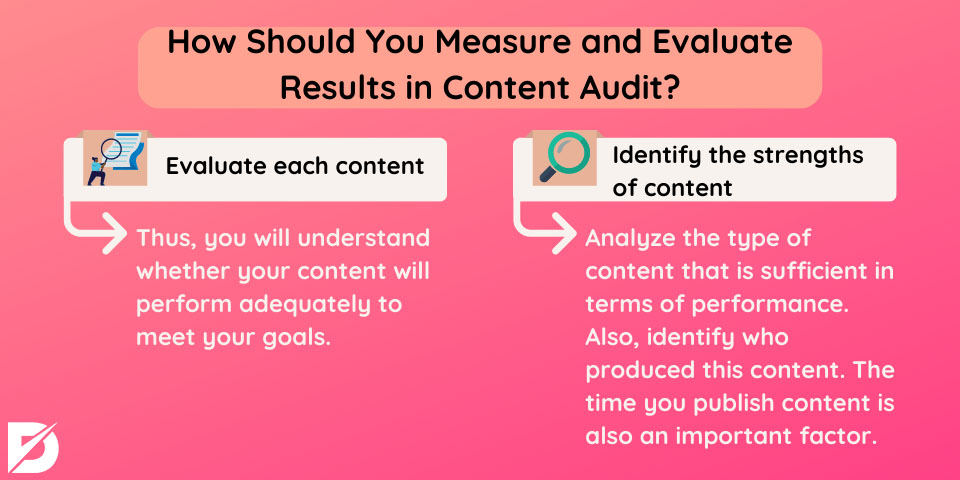
Performing the steps we have listed above will help you maintain your success. Because in this way, you will be able to keep producing successful content with the same methods. That is one of the main purposes of content moderation.
But what about content that doesn’t contribute anything to achieving your goals? That is exactly the other main purpose of content audit. So, detect content that is underperforming in meeting your goals. Then, analyze these contents in detail in terms of the metrics we have mentioned. Thanks to the data you’ll obtain from these analyses, you can determine the reasons for the failure of these contents. For example, one of the reasons for the content to fail may be that you publish it on the wrong channels. So, your content is not of poor quality. All you have to do is analyze well which channels you should share it. Similarly, the date you publish can have a similar effect.
Using Google Search Console in Content Audit
GSC is a unique tool with great features for content marketers. Not to mention that the tool is completely free. So, how can you use this amazing insight tool for the content audit? One of the most prominent features of GSC is the insights it offers on click-through rates. You can also get great data on keyword positions with this tool. You can analyze this data to evaluate the extent to which your content affects rankings.
An active Google account is all you need to use the GSC tool. In this way, you can easily connect the tool to the website of your choice. Finally, verify the domain. After you complete these steps, go to the Performance tab of the tool to review the data we have mentioned. Through this tab, first, enable average click-through rates. Then, enable the average position. In this way, you can benefit more clearly from the insights we have mentioned. Then, take a look at the top right corner of the screen. Here, you will see the export button. Click this button. Then, enable the CSV option. In this way, you will be able to export the data you need from the GSC tool for content control.
Using Google Analytics in Content Audit
The GA tool is likewise another essential tool for content marketers. Although this tool is completely free, it also has great features. For this reason, you will also need the data you will provide from this tool in content control. In order to use this tool in content audit, all you have to do is export the data of the tool. First, connect your tool to a website. The tool will collect a lot of data for every element on your website and provide you with insights. So, which reports should be your priority to export for content auditing in this tool?
The first of the reports that you should prioritize in this regard is acquisition. The page content report of this tool then provides priority insights that you should benefit from in content moderation. It is also important for content audit that you export the targets report from the GA tool. So, what kind of evaluations can you get with these reports that you will export from the GA tool?
The insights you gain from these reports first help you identify the sources of traffic to your website. Besides, you can determine which web pages have the best performance thanks to these reports. The reports we have listed also provide important insights into how your content reaches your goals. Let’s also explain how you can export these reports.
First of all, switch to the tabs related to the reports we mentioned in the GA tool. You’ll see the export button in the upper right corner of the screen that each tab will open for you. By clicking this button, you can export the reports in question.
Content Audit and Competitive Analysis
Competitor analysis is a vital part of content auditing. It helps you understand how your competitors engage with the same target audience. Analyze their content to find opportunities for improvement or new ideas for your own site. If your competitor’s content is outperforming yours, consider whether your content strategy or channels need adjustment.
As we have mentioned, competitor analysis makes a significant contribution to you in another issue. Everything about your content can be good. You may have difficulty identifying where the problem originates when this is the case. In such cases, performing competitor analysis helps you find answers to your questions. So, how? Thanks to competitor analysis, you can identify your competitors’ content related to the subject or field of your content.
If you have enough time in the content audit, we recommend that you analyze this content in terms of quality. Seeing that these contents are of much higher quality than their counterparts on your website will provide you with an important clue. At this point, you will be able to understand why content that has no problems on your website cannot attract enough traffic. Because the audience interested in this content flows to the page with higher quality content on your competitor’s website. So, what should you do in this situation?
In such cases, if you have enough time, you can make the said content even more perfect. However, that may be very time-consuming. So, instead of dealing with such content, you may prefer to spend your energy and resources on improving your website in other aspects. At least you understand that you shouldn’t mess with these contents anymore.
How to Set Goals for Content Audit
Before starting a content audit, set clear goals. These might include:
- Improving SEO: Audit content for SEO metrics like keyword rankings, backlinks, and organic traffic.
- Increasing Conversion Rates: Focus on content that drives sales or leads.
- Boosting Audience Engagement: Identify which content generates the most shares, likes, and comments.
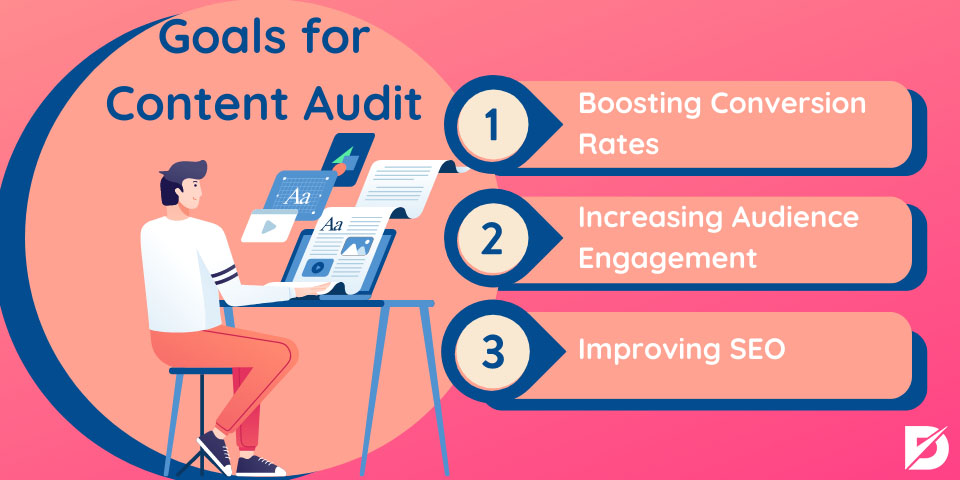
Boosting Conversion Rates
One of the most common goals of this process is to increase conversion rates. If you are performing the content audit for this purpose, there are some issues that you should prioritize. First of all, identify the web pages that generate the most sales. In this way, you can more clearly reveal what type of content contributes the most to sales. Besides, identify the web pages with the best performance in terms of user experience. Thus, you can understand how to improve other content on your website in terms of contributing to sales. There is another important aspect of the goal of increasing conversion rates.
It is quite important to include content that appeals to every stage of the buyer’s journey on a website. For this reason, consider this process while improving the content on your website in terms of contributing to sales. Your website may not contain content that addresses every aspect of the buyer’s journey. In this case, focusing on these missing points in your content creation efforts will help you eliminate this problem.
Increasing Audience Engagement
If you have such a goal, you should first evaluate the content on your website in terms of engagement performance. Identify the content that your target audience is most engaged with on your website. For example, determining which content is shared the most on social networks may be a good start. Here, write down the contents that are suitable for the results you have achieved so far. In this way, you can identify the most popular topic types among your visitors. In light of this data, you can create content that will attract the attention of your target audience in the future.
Improving SEO
In this process, do not only perform SEO content audits. Performing a general SEO audit will actually be much more beneficial for your website. In this process, first, determine which web pages rank better. At the same time, it will be extremely useful to determine the content that attracts the most organic traffic. So, let’s give some tips to make this process easier for you.
In this process, the Google Analytics tool will make a great contribution to you. This tool allows you to identify the pages that get the most views. In this way, you can get data on identifying your content that can rank higher in search results. Thanks to GA, you can also gain important insights to improve internal links on your website. Besides, you will be able to determine the web pages that you need to update in terms of SEO, thanks to this tool. Thanks to the important insights GA provides, you can easily identify the pages that harm your website in terms of SEO. In this way, you can contribute to SEO by removing or improving these contents from your website.
There are other important elements that you should examine in an SEO content audit. In this process, you should examine your content in terms of title tags and meta descriptions. Also, do not forget to evaluate the backlinks and alternative texts of the content. Duplicate content on your website can also have a significant impact on SEO. For this reason, identify these contents and remove them from your website. Optimizing your website in the aspects we have listed above will be very beneficial for the best-ranking result.
What Benefits Can You Get From the Content Audit Process?
Thanks to the content audit, you clean your website figuratively. In this way, you will contribute to your marketing strategy in many ways. Thanks to the content audit, first of all, you evaluate your content strategy in detail. So, you can think of these studies as a comprehensive website inventory. You can get a bird’s-eye view of the overall work you have done on your website. So, what elements can you evaluate your website holistically in this bird’s-eye view?
In this way, you can have a clearer view of your video or blog posts. The same is true for infographics and landing pages on your website. That clear view will allow you to see important elements that you have overlooked or neglected. Many websites waste resources on certain topics and areas unnecessarily. Thanks to the content audit, you can also detect such issues. Thus, you can be sure that you spend your resources on more necessary matters.
Content strategies are generally about more micro-scale details. Thanks to the content audit, you get out of this micro-scale and have a macro perspective. That means that you can undoubtedly gain very new perspectives on your marketing strategy.
Through the content audit, you also discover ways to improve website SEO. You can direct your future content production process with the concrete data you will get from the content audit. Another advantage of the content audit is that it reveals topics and areas that you neglect. In this way, you can complete the deficiencies of your website. You can even be inspired by this process for much newer ideas for your website. Finally, thanks to the content audit, you can make content perfect. That will naturally allow you to achieve higher rankings.
What Are the Types of Content Audits?
There are five main types of content audits:
- Full Content Audit: A complete review of all content assets on your website.
- Partial Content Audit: A review of content published during a specific period or on a specific topic.
- Content Sample Audit: A focused audit of selected content pieces.
- Content Marketing Audit: An audit focusing on the marketing performance of your content.
- SEO Content Audit: An audit that evaluates content for SEO performance.
Let’s explain what they mean now. Let’s start with the full content audit first. It refers to the process of taking a complete inventory of content assets. In this process, you need to analyze all the content on your website. Then, thanks to the data you will get from these analyzes, you should make your content even better.
You can understand what partial content audit means from the name. It refers to auditing the content on your website in only one or a couple of aspects. For example, you can audit the content that you have published on your website only in a certain time period. Or, you can choose to focus only on content on specific topics instead. You may even determine the content you will audit according to the channels you have broadcast them.
There is a similar situation with the partial content audit in the content example audit. Here, too, you choose to audit only a specific instance of content. There is a fundamental difference between these two types of content audits. Here you only perform an audit of the selections of the sample content entities.
Content marketing audit, on the other hand, is quite comprehensive. In this process, you have to audit all your existing content assets. You should also consider many metrics in this evaluation process.
SEO content auditing is also quite extensive. In this process, you don’t just audit your content assets. You should also evaluate each post for the most important SEO factors. So, what are these top SEO metrics? Only you can determine these important SEO metrics according to your goals.
How to Perform a Content Audit, In Short
Content auditing is a time-consuming but essential process to maintain and improve the quality of your website. Whether you focus on SEO, user engagement, or conversion rates, regularly auditing your content ensures you stay ahead in a rapidly changing digital landscape. Conduct audits at least monthly, or weekly for the best results.
Frequently Asked Questions About
There are five types of content audit. These are full content audit, partial content audit, content sample audit, content marketing audit, and SEO content audit.
You can use Spreadsheets, Google Sheets, Screaming Frog, URL Profiler, Google Search Console, and Google Analytics. You can also use plugins, such as My Site Audit and Rank Math WordPress.
This process refers to detecting what kind of content you should not have on your website. For example, your website should have content that appeals to every stage of the sales journey. If your website doesn’t contain content that addresses every stage of the sales journey, you can detect this with content gap analysis.
For this, you have to check messaging, clarity and accuracy, readability, grammar, syntax, and punctuation.
These metrics are backlinks, organic traffic, keyword rankings, and dwell time.


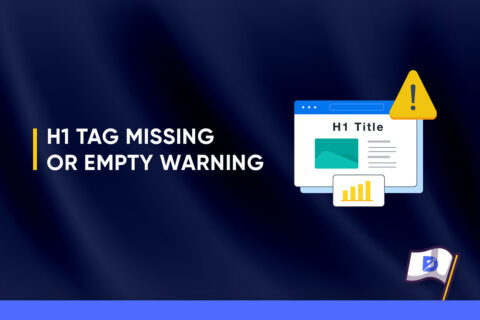


No comments to show.